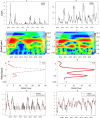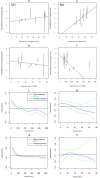Transmission center and driving factors of hand, foot, and mouth disease in China: A combined analysis
- PMID: 32150558
- PMCID: PMC7062235
- DOI: 10.1371/journal.pntd.0008070
Transmission center and driving factors of hand, foot, and mouth disease in China: A combined analysis
Abstract
Hand, foot, and mouth disease (HFMD) has become a major public health issue in China. The disease incidence varies substantially over time and across space. To understand the heterogeneity of HFMD transmission, we compare the spatiotemporal dynamics of HFMD in Qinghai and Shanghai by conducting combined analysis of epidemiological, wavelet time series, and mathematical methods to county-level data from 2009 to 2016. We observe hierarchical epidemic waves in Qinghai, emanating from Huangzhong and in Shanghai from Fengxian. Besides population, we also find that the traveling waves are significantly associated with socio-economic and geographical factors. The population mobility also varies between the two regions: long-distance movement in Qinghai and between-neighbor commuting in Shanghai. Our findings provide important evidence for characterizing the heterogeneity of HFMD transmission and for the design and implementation of interventions, such as deploying optimal vaccine and changing local driving factors in the transmission center, to prevent or limit disease spread in these areas.
Conflict of interest statement
The authors have declared that no competing interests exist.
Figures




Similar articles
-
Risk Assessment and Mapping of Hand, Foot, and Mouth Disease at the County Level in Mainland China Using Spatiotemporal Zero-Inflated Bayesian Hierarchical Models.Int J Environ Res Public Health. 2018 Jul 12;15(7):1476. doi: 10.3390/ijerph15071476. Int J Environ Res Public Health. 2018. PMID: 30002344 Free PMC article.
-
Spatiotemporal Dynamics of Hand-Foot-Mouth Disease and Its Relationship with Meteorological Factors in Jiangsu Province, China.PLoS One. 2015 Jun 29;10(6):e0131311. doi: 10.1371/journal.pone.0131311. eCollection 2015. PLoS One. 2015. PMID: 26121573 Free PMC article.
-
Integration of a Kalman filter in the geographically weighted regression for modeling the transmission of hand, foot and mouth disease.BMC Public Health. 2020 Apr 10;20(1):479. doi: 10.1186/s12889-020-08607-7. BMC Public Health. 2020. PMID: 32276607 Free PMC article.
-
A spatiotemporal mixed model to assess the influence of environmental and socioeconomic factors on the incidence of hand, foot and mouth disease.BMC Public Health. 2018 Feb 20;18(1):274. doi: 10.1186/s12889-018-5169-3. BMC Public Health. 2018. PMID: 29463224 Free PMC article.
-
[Prevalence and Analyses of the Changing Etiology of Hand, Foot and Mouth Disease in China].Bing Du Xue Bao. 2015 Sep;31(5):554-9. Bing Du Xue Bao. 2015. PMID: 26738295 Review. Chinese.
Cited by
-
Combined impacts of environmental and socioeconomic covariates on HFMD risk in China: A spatiotemporal heterogeneous perspective.PLoS Negl Trop Dis. 2023 May 19;17(5):e0011286. doi: 10.1371/journal.pntd.0011286. eCollection 2023 May. PLoS Negl Trop Dis. 2023. PMID: 37205641 Free PMC article.

